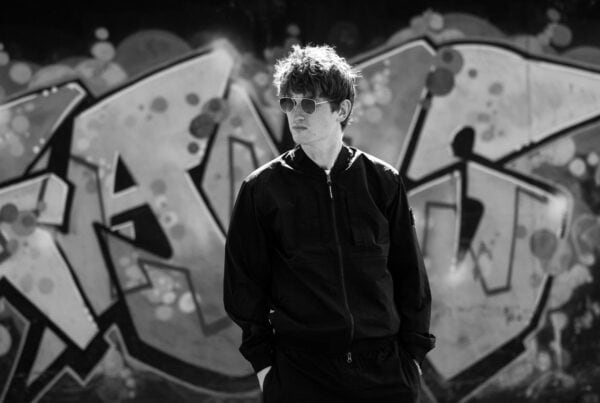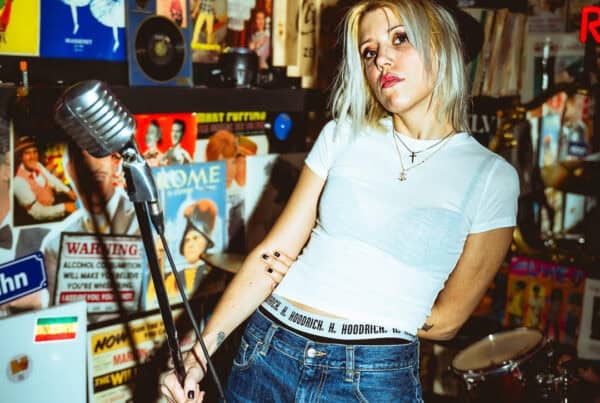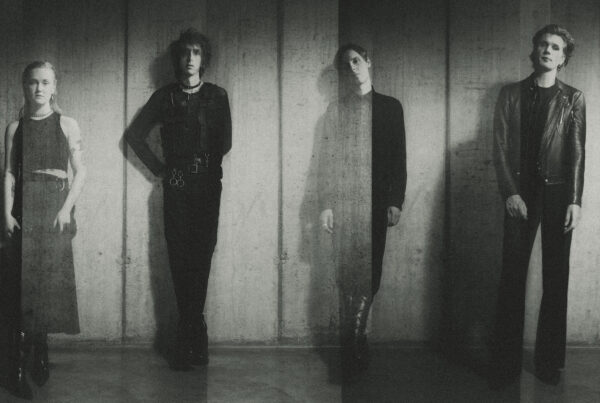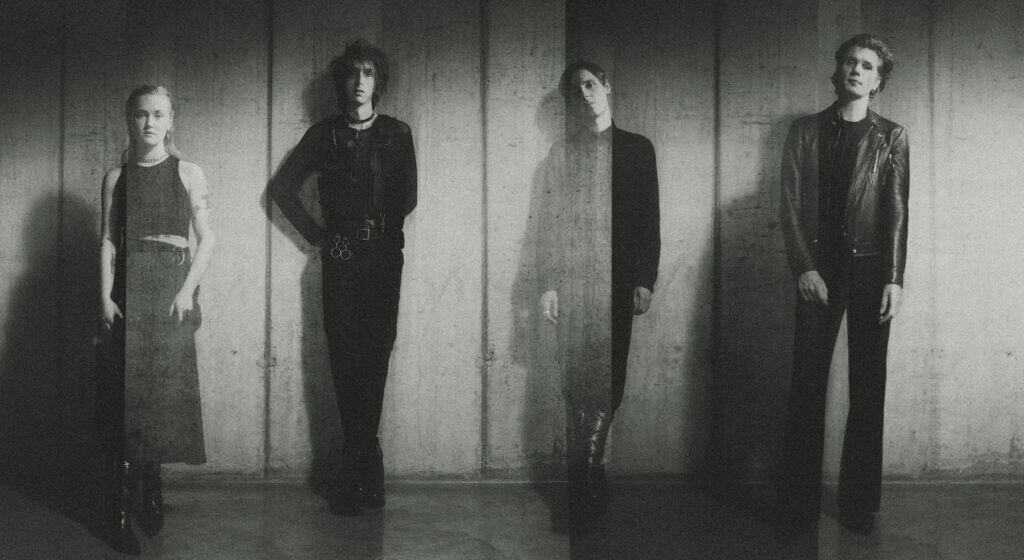Crispin Glover a truly unique individual. Wholly personable and dedicated to his art, the actor is probably best known for his roles in films such as ‘Back to the Future’, ‘Charlie’s Angels’, ‘Alice In Wonderland’, ‘The River’s Edge’, ‘Rubin And Ed’ and ‘Willard’. When he’s not thrusting his quirky nature upon us via the screen, Crispin is hard at work on his own award-winning productions including ‘What Is It?’, and ‘It Is Fine! EVERYTHING IS FINE!’, and of course, ‘Crispin Hellion Glover’s Big Slide Show’. We catch up with the enigmatic star as he brings the show into London, to talk about his career, making music and some plans for 2012.
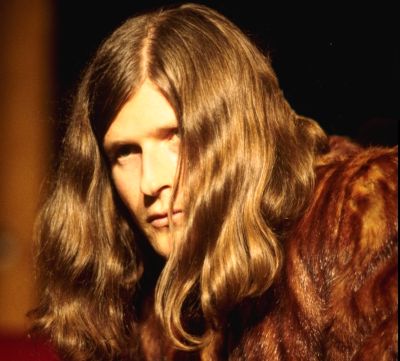
“Everyone is an individual. That is part of what makes the world interesting”
S] How did you look forward to these London shows?
C] “I am continuously grateful to the audiences and venues that have my shows and attend the shows. Without them these films and shows would not be possible for me to continue to make.”
S] What are some of the biggest challenges you have come up against in touring your various works in the past?
C] “The largest challenge is the sheer amount of time and energy it takes to continue to tour as a lifestyle. In the last six years it has altered how I live vastly. I used to be in a single city for many months or even years at a time. Now, it is rare that I am somewhere longer than three weeks. It has large effects on my social life and lifestyle. I am not complaining, but it can have difficulty, but if I were to choose between touring with my films and not having people see them I would definitely choose to tour.”
S] Can you explain your goals when putting together your Big Slide Show concept and touring it live?
C] “The live aspect of the shows is not to be underestimated. This is a large part of how I bring audiences in to the theater and a majority of how I recoup is by what is charged for the live show and what I make from selling the books after the shows.
For ‘Crispin Hellion Glover’s Big Slide Show’, I perform a one-hour dramatic narration of eight different books I have made over the years. The books are taken from old books from the 1800s that have been changed in to different books. They are heavily illustrated with original drawings and reworked images and photographs.
I started making my books in 1983 for my own enjoyment without the thought of publishing them. I had always written, and drawn and the books came as an accidental outgrowth of that. I was in an acting class in 1982 and down the block was an art gallery that had a book store upstairs. In the book store there was a book for sale that was an old binding taken from the 1800s and someone had put their art work inside the binding. I thought this was a good idea and set out to do the same thing.
I worked a lot with India ink at the time and was using the India ink on the original pages to make various art. I had always liked words in art and left some of the words on one of the pages. I did this again a few pages later and then when I turned the pages I noticed that a story started to naturally form and so I continued with this. When I was finished with the book, I was pleased with the results and kept making more of them. I made most of the books in the 80s and very early 90s. Some of the books utilise text from the binding it was taken from and some of them are basically completely original text.
Sometimes I would find images that I was inspired to create stories for, or sometimes it was the binding or sometimes it was portions of the texts that were interesting. Altogether, I made about twenty of them. When I was editing my first feature film ‘What Is It?’ There was a reminiscent quality to the way I worked with the books because as I was expanding the film in to a feature from what was originally going to be a short. I was taking film material that I had shot for a different purpose originally and re-purposed it for a different idea and I was writing and shooting and ultimately editing at the same time. Somehow I was comfortable with this because of similar experiences with making my books.
When I first started publishing the books in 1988 people said I should have book readings. But the books are so heavily illustrated and they way the illustrations are used within the books, they help to tell the story; so the only way for the books to make sense was to have visually representations of the images. This is why I knew a slide show was necessary. It took a while but in 1992 I started performing what I now call ‘Crispin Hellion Glover’s Big Side Show Part 1’. The content of that show has not changed since I first started performing it. But the performance of the show has become more dramatic as opposed to more of a reading.
People sometimes get confused as to what ‘Crispin Hellion Glover’s Big Slide Show’ (Parts 1 and 2) is, so now I always let it be known that it is a one hour dramatic narration of eight different profusely illustrated books that I have made over the years. The illustrations from the books are projected behind me as I perform. There is a second slide show now that also has eight books. Part 2 is performed if I have a show with Part 1 of the ‘IT’ trilogy and then, on the subsequent night I will perform the second slide show and Part 2 of the ‘IT’ trilogy. The second slide show has been developed over the last several years and the content has changed as it has been developed, but I am very happy with the content of the second slide show now.
The fact that I tour with the film helps the distribution element. I consider what I am doing to be following in the steps of vaudeville performers. Vaudeville was the main form of entertainment for most of the history of the US. It has only relatively recently stopped being the main source of entertainment, but that does not mean this live element mixed with other media is no longer viable. In fact it is apparent that it is sorely missed.”
S] What is Volcanic Eruptions?
C] “It was a business I started in Los Angeles in 1988 as Crispin Hellion Glover doing business as Volcanic Eruptions. It was a name to use for my book publishing company. About a year later, I had a record and CD come out with a corporation called Restless Records. About when I had sold the same amount of books as CDs, it was very clear to me that because I had published my own books there was a far greater profit margin. It made me very suspicious of working with corporations as a business model. Financing and producing my own films is based on the basic business model of my own publishing company. There are benefits and drawbacks about self-distributing my own films. In this economy it seems like touring with the live show and showing the films with a book signing is a very good basic safety net for recouping the monies I have invested in the films.
There are benefits that I am in control of the distribution and personally supervise the monetary intake of the films that I am touring with. I also control piracy in this way because digital copy of this film is stolen material and highly prosecutable. It is enjoyable to travel and visit places, meet people, perform the shows and have interaction with the audiences and discussions about the films afterwards. The forum after the show is also not to under-estimated as a very important part of the show for for the audience. This also makes me much more personally grateful to the individuals who come to my shows as there is no corporate intermediary. The drawbacks are that a significant amount of time and energy to promote and travel and perform the shows. Also the amount of people seeing the films is much smaller than if I were to distribute the films in a more traditional sense.
The way I distribute my films is certainly not traditional in the contemporary sense of film distribution but perhaps is very traditional when looking further back at vaudeville-era film distribution. If there are any film-makers that are able to utilise aspects of what I am doing then that is good. It has taken many years to organically develop what I am doing now as far as my distribution goes.”
S] You have been creating the books from which you read since the early 1980s – do you still get the same “buzz” from it now as you did back then?
C] “The performance of the first slide show is quite automatic to me because I have performed it for so long. I always enjoy the aspect of performing that show. The second slide show is still newer to me though, and so there is a bit more of a mental preparation for that show.”
S] Does your desire to explore taboo in contemporary culture ever influence your decision when taking up corporately funded mainstream projects?
C] “Yes. Steven C. Stewart wrote and is the main actor in part two of the trilogy titled ‘It Is Fine! EVERYTHING IS FINE.’ I put Steve in to the cast of ‘What Is It?’ because he had written this screenplay which I read in 1987. When I turned ‘What Is It?’ from a short film in to a feature I realised there were certain thematic elements in the film that related to what Steven C. Stewart’s screenplay dealt with. Steve had been locked in a nursing home for about ten years when his mother died. He had been born with a severe case of Cerebral Palsy and he was very difficult to understand. People that were caring for him in the nursing home would derisively call him an ‘M.R’ short for ‘Mental Retard’. This is not a nice thing to say to anyone, but Steve was of normal intelligence.
When he did get out he wrote his screenplay. Although it is written in the genre of a murder detective thriller, truths of his own existence come through much more clearly than if he had written it as a standard autobiography. Originally, the film was going to be a short to promote the idea to corporate film funding entities of working with a cast wherein most characters are played by actors with Down’s Syndrome. Steve had written his screenplay in in the late 1970s. I read it in 1987 and as soon as I had read it, I knew I had to produce the film. Steve died within a month after we finished shooting. Cerebral Palsy is not generative but Steve was 62 when we shot the film. One of Steve’s lungs had collapsed because he had started choking on his own saliva and he got pneumonia.
When his lung collapsed in the year 2000 this was around the same time that the first ‘Charlie’s Angels’ film was coming to me. I realised with the money I made from that film I could put that straight in to the Steven C. Stewart film. That is exactly what happened. I finished acting in ‘Charlie’s Angels’ and then went to Salt Lake City where Steven C. Stewart lived. I met with Steve and David Brothers with whom I co-directed the film. I went back to LA and acted in an lower budget film for about five weeks and David Brothers started building the sets. Then I went straight back to Salt Lake and we completed shooting the film within about six months in three separate smaller productions.
I am greatly relieved to have completed it especially since I am very pleased with how well the film has turned out. We shot ‘It is fine! EVERYTHING IS FINE.’ while I was still completing ‘What Is It?’ And, this is partly why ‘What Is It?’ took a long time to complete. I am very proud of the film, as I am of ‘What is it?’ I feel ‘It is fine! EVERYTHING IS FINE.’ will probably be the best film I will have anything to do with in my entire career.
After ‘Charlie’s Angels’ came out it did very well financially and was good for my acting career. I started getting better roles, that also paid better and I could continue using that money to finance my films that I am so truly passionate about.
I have been able to divorce myself from the content of the films that I act in and look at acting as a craft that I am helping other film-makers to accomplish what it is that they want to do. Usually film-makers have hired me because there is something they have felt would be interesting to accomplish with using me in their film, and usually I can try to do something interesting as an actor.
If for some reason the director is not truly interested in doing something that I personally find interesting with the character then, I can console myself that with the money I am making to be in their production, I can help to fund my own films that I am so truly passionate about. Usually though I feel as though I am able to get something across as an actor that I feel good about. It has worked out well!”
S] There are a number of theatre companies around now (the UK’s Mind The Gap is one) that work to promote the skills of people with various learning difficulties when it comes to performing arts, is this something that you are a supporter of, as someone who has worked with people who have much talent despite having Cerebral Palsy (‘It Is Fine! EVERYTHING IS FINE!’) and Down’s Syndrome (‘What Is It?’)?
C] “Yes. I fully support the performing arts for all people that are enthusiastic to perform.”
S] What skills have you learned on sets for mainstream films that you have starred in that has benefited you when working independently?
C] “I would say that concentration is the most important aspect for me as an actor in film no matter what the budget.”
S] Where do you find the greatest source of inspiration as a creator – can it be from a particular place you like to visit, or, is it the people who surround you that are the biggest drivers?
C] “I find that my work as a film-maker is reactive, whether the reaction is from control that exists in the media or the space that I will have available to shoot in, there is a reaction to something that ends up inspiring me.”
S] How do you keep yourself motivated as someone who is constantly self-promoting and self-publishing alongside working in the mainstream film industry?
C] “I am always grateful when I am offered work as an actor no matter what the budget. Generally if I feel I can do well playing the role and the offer fits my quote, I will accept.”
S] What would you say your biggest strength as a performer is?
C] “When I am able to concentrate well, I can get in to the proper psychological mindset of the character. That is key for me to give a good performance.”
S] Do you find yourself still learning anything about your industry, considering all that you have achieved?
C] “Yes, there are always things to learn, but the most important thing to have is a good attitude.”
S] Can you talk us through your 2011?
C] “2011 was a big touring year for me. I toured in Canada, all over the UK, the US Northwest, Texas, Arkansas, Oklahoma, New York, Boston, Iceland, Poland, and now back in London. Touring will continue next year in Nashville, Chicago, Penn State University and Ottawa Canada. I also acted in a film in the Summer. It is based on an Elmore Leonard novel by the title of ‘Freaky Deaky’; I also began building sets for my next production at my property in the Czech Republic. So there really has been a lot of travelling this year going to all these places.”
S] How will you be continuing work on the ‘It’ Trilogy in 2012?
C] “I will continue to tour with the first two films of the trilogy in 2012. The work at my property in the Czech Republic benefits the future production of the final film of the ‘IT’ trilogy but that will not be my next production.”
S] One of our favourite films of yours is ‘Willard’. Can you talk us through the preparation you went through for the role – how did that challenge you as a performer?
C] “I very much enjoyed playing ‘Willard’. I worked very hard on the emotional aspects in playing the role. I did not see the original film until after a deal had been reached for me to appear in the version that I did. I wanted to see of there was anything I could glean from Bruce Davison’s performance. When I viewed the 1971 ‘Willard’, I liked it and thought Bruce’s performance was excellent, but the screenplay I had read was a substantially different character from what the character was in the 1971 film, so I had to go in to the screenplay while figuring out the character. I had an excellent time working on that film. I am proud of the emotional work that I concentrated on very hard while making that film. The rodents that I worked with were exceedingly well trained and never made a mistake on a single take, which was great because a lot of the scenes I had with them were emotional scenes that would have been hard to get to again if cuts had to be because of the rats. But rats were perfect every time and ultimately great acting partners!”
S] How do you look back on your music and the ‘The Big Problem = The Solution. The Solution = Let It Be’ record you released?
C] “I am proud of the record ‘The Big Problem ≠ The Solution. The Solution = Let It Be’. We worked on the album for I believe about three years by the time it was released. I was approached by Barnes and Barnes [‘Fish Heads’] who wanted to record with me. I knew their work and thought it would be a lark to record something with them. I recorded some things and then they let me know they were interested in making an album.
It became apparent to me that a concept should be had and so I thought about some of what had been recorded and realised there already was a bit of a theme and that by recording other new things and getting rid of some of the things that were already completed, a good concept could come out of it. This is where ‘The Big Problem ≠ The Solution. The Solution = Let It Be’ came from. There was a related theme in all the pieces on the album. The album came out in 1989 and this was well before the Internet so a telephone number (not my home number) was printed on the album for people to call with their answer. Many people figured it out. The telephone message let people know information about how to order my books. There is another album’s worth of material that has small finishes that need to be made to release it. My mind mostly, is on making and distributing my films and acting in other’s films. One of my favourite parts of making the films is working with the music for the films. Performing music is much lower on my priorities, but I am proud of the album and I need to put the second one out at some point.”
S] Do you have a different mind-set when creating film (which deals with strong character development) to when you have created music, which appears to be much lighter in tone?
C] “Yes, there is a significantly more work creating and finishing a film than creating and finishing a record. For me there is much more thought involved in my films than in the record I put out. It does not mean I am not proud of the record, as I am, but just in terms of the amount of work there is a lot more work in making a film. The work covers many different areas that making a record does not have.”
S] Is there an actor or director from past or present that you feel shares your values and ideas?
C] “Everyone is an individual. That is part of what makes the world interesting. But there are film-makers working today that I certainly admire. A few examples are: Werner Herzog [‘Cave Of Forgotten Dreams’], David Lynch [‘Eraserhead’], Akira Kurosawa [‘Dreams’] Todd Browning, [‘Freaks’] and FW Marnau [‘Nosferatu’].”
S] What are your aims in the New Year 2012?
C] “I plan to shoot my first production at my property in the Czech Republic.”
S] You are working on a screenplay with your father, correct?
C] “I am in the process of writing a screenplay for myself and my father to act in together. He is also an actor and that is the next film I am planning to make as a director and producer. This will be the first role I write for myself to act in that will be written as an acting role as opposed to a role that was written for the character I play to merely serve the structure. But even still, on some level I am writing the screenplay to be something that I can afford to make. There are two other projects I am currently developing to shoot on sets at my property in the Czech Republic. The cost of the set building will determine which one I actually shoot next. They will all be relatively affordable yet still cinematically pleasing.”
S] How are you celebrating Christmas this year?
C] “I will fly from London to LA and spend Christmas with my parents.”
S] Do you have anything that you would like to add for your UK audience?
C] “The best way to find out where I will be with my shows and films is by signing up for the newsletter on CrispinGlover.com or by joining me on Facebook. I look forward to seeing people at the shows. Thank you!”
For more information, click the links.
Enjoy Crispin Glover’s music video for ‘Clownly Clown Clown below.

